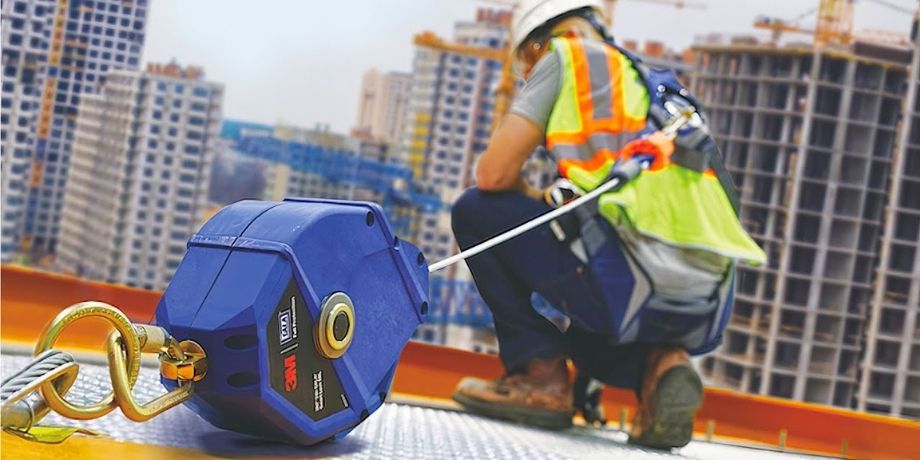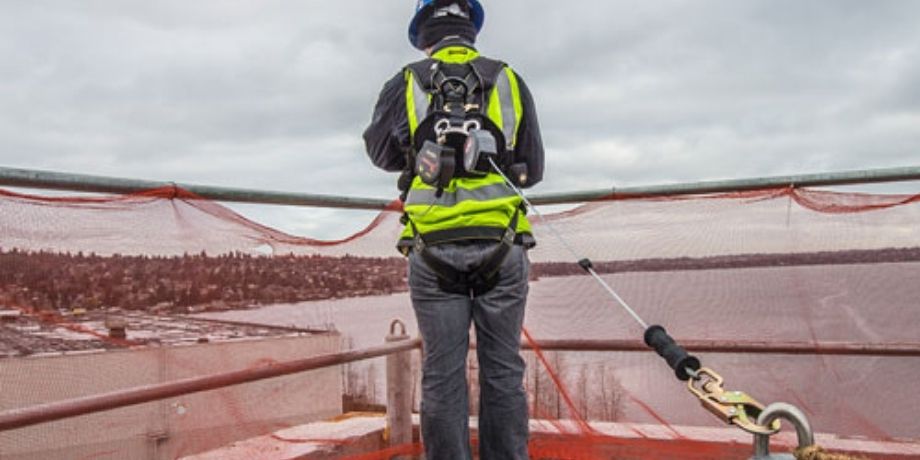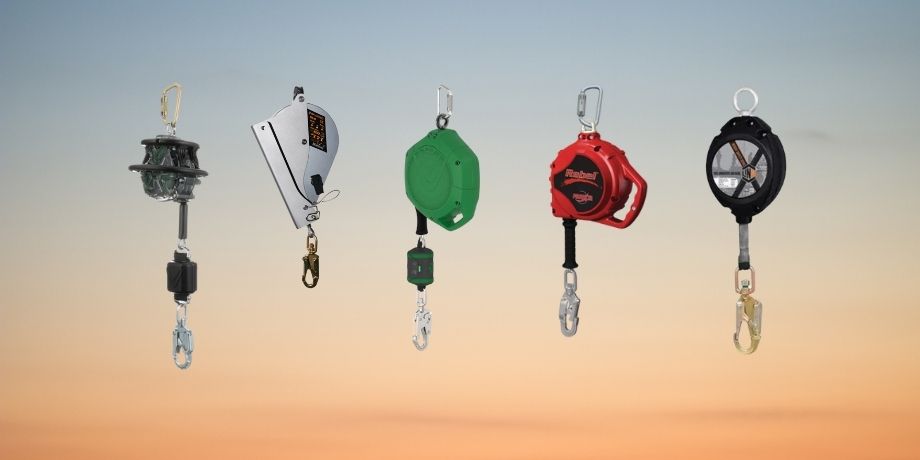
Using a self-retracting lifeline (SRL) on a roof offers both flexibility and fall protection – making it a great choice for roof workers. But have you got the right SRL? And do you know how to stay safe while using it? Here’s your Need to Know’s when using an SRL for roof work.
HOW DOES AN SRL WORK?
There are three key components to an SRL
A self-retracting lifeline typically incorporates three key components – a lifeline, a housing unit which protects that lifeline, and secure connectors. The type of connectors and lifeline material (webbing vs cable) required will depend on intended application.
An SRL connects you to a fall arrest anchor point
An SRL is designed to securely connect you to a fall arrest anchor point. The location of this anchor point may be anywhere from directly overhead to foot level.
Note: A foot-level anchor point is more likely when working on a roof and must be carefully considered when choosing an SRL due to its impact on fall clearance and probability of exposure to a roof edge.
An SRL works like a seatbelt to arrest your fall
A self-retracting lifeline (SRL) automatically retracts and expands as you move. This reduces any slack in the line, which enables smooth movement and eliminates your SRL as a trip hazard.
Should you fall, your SRL will automatically lock in place to arrest that fall. The sudden force of the fall engages an automatic braking system (situated inside the housing unit) which will lock immediately to restrict fall distance.
This seatbelt-like design is a literal lifesaver. Not only will it arrest your fall – it’ll also hold you in place (as long as the SRL remains under tension) and help to minimise potential injuries.
HOW TO CHOOSE YOUR SRL

Start with the location of your anchor point
The position of your anchor point in relation to your work area and to any roof edge or fall hazard is the first thing to consider. This may impact the class of SRL you should use (see below) and also the maximum safe length of any SRL (in order to minimise fall distance and ensure fall clearance).
Look for exposure to any sharp or leading edges
When working on a roof, your SRL is more likely to be exposed to sharp and/or leading roof edges – which would affect your SRL options (see below).
In practical terms, a sharp edge is one that is not rounded and has the potential to cut or even sever your lifeline. A roof edge may also be considered a leading edge if a worker is anchored at foot level (also called a foot level tie off) and exposed to falling off the edge (whether it is sharp or not).
Identify the correct class of SRL to use
The key height safety standard that is applicable to SRLs is AS/NZS 1891.3.
In addition to this standard, ANSI/ASSP Z359.14-2021 makes a clear distinction between products that are designed for use with an overhead anchor point only (Class 1) vs products that have been rated for use near a leading edge (Class 2).
For example:
- If your anchor point is at or above the level of the dorsal D-ring on your harness, it is considered an overhead anchor point and you’ll need a Class 1 SRL
- If your SRL could be exposed to a leading edge (irrespective of whether the anchor point is overhead or not) you must use a Class 2 SRL
Note: When working on a roof, you are less likely to be using an overhead anchor point and more likely to be near a roof edge.
Find the right SRL for your application

The types or categories of self-retracting lifelines available have evolved over time. Here are the main (broad) ones:
| Summary | When to use | When Not to use | |
|---|---|---|---|
| Standard SRL | Standard SRLs come with standard components and offer multiple anchorage options. As such, they can be used in a variety of applications | Ideal starting point if you don’t need to mitigate hazards (like leading edges) and you don’t need additional features (such as rescue capability) | Do not use a Standard SRL over a leading edge or in a rescue scenario |
| Leading Edge SRL | Leading edge SRLs feature materials (such as cable or thick webbing) that have been built to withstand contact with sharp or leading edges | If working around sharp edges, you must always use a leading edge SRL. Can also be used with foot-level anchor points (useful for roof work) | Not suitable for rescue applications |
| Rescue SRL (or Type 3 Retrieval ) | Rescue SRLs come with integrated rescue functionality (ie retrieval winch and bracket) that allow them to be quickly fitted to rescue tripods in order to help lift a fallen worker | Ideal for building some basic rescue capability if needed | Due to its rescue features, a Rescue SRL should not be used as a Personal SRL |
| Personal SRL | Personal SRLs are typically lighter, more compact, have a shorter lifeline and, as such, can be directly connected to the dorsal D-ring on your harness | Ideal for sites with a relatively small work area and limited fall clearance | Personal SRLs offer limited mobility so may not be ideal for a sizeable work area |
Consider material, connector and user requirements
Self-retracting lifelines are available in a range of lengths. They’re also made with different materials and can be fitted with a variety of connectors. Therefore, it’s important to consider environmental factors and user requirements when choosing your SRL.
For example, could the SRL be exposed to chemicals, extreme temperatures, sharp or leading edges (as above) or other abrasive conditions? If so, a stainless steel or galvanised steel cable SRL would be more suitable because it’s built to withstand harsh environments.
Conversely, in more benign environments, a lighter, more comfortable and less restrictive webbing SRL (nylon or polyester) may be suitable. Webbing SRLs are also non-conductive, making them the only choice should there be any exposure to an electrical hazard.
SRLs can also be fitted with different connectors and/or carabiners. These must be suitable for your anchor point at one end and harness at the other. Also, for added safety, look for those that can swivel, as this allows users to turn and twist without tangling the lifeline.
Other user needs to consider include the length of lifeline required (for maximum mobility minimum fall distance and sufficient fall clearance) and maximum user weight capacity (sufficient for user and tools or equipment being carried).
| DID YOU KNOW? An SRL is known by many names. When shopping for a self-retracting lifeline, keep in mind that it may also be called a yo-yo, a fall arrest block/device, an inertia reel or a retractable lanyard (amongst others). So if in doubt, get advice before you buy SHOP SRL’s > |
USING YOUR SRL ON A ROOF
Inspect your SRL before every use
It’s necessary and best practice to routinely inspect all of your height safety gear and equipment before use, including your SRL.
Your first priority is to check the fall indicator on your SRL (typically a visual indicator) which activates whenever a fall occurs. If the fall indicator has been activated, your SRL must be immediately removed from service and inspected by a competent person (typically a height safety specialist).
Other safety checks include inspecting the housing unit for cracks or damage and the lifeline for cuts, tears, burn marks, fraying, corrosion or other signs of wear and tear. Also ensure the lifeline extends and retracts smoothly and give it a sharp tug to test the braking mechanism. Finally check all hooks, connectors and/or carabiners.
Should anything be amiss, do not use your SRL until it has been re-certified.
Follow your training and the manufacturers instructions
As with all height safety equipment, you must follow your SRL manufacturer’s instructions for use at all times. You must also have sufficient work-at-height training under your belt before undertaking work on a roof – in particular, the knowledge and skills to calculate fall clearance.
Using your SRL when working in fall arrest or restraint
Working in fall arrest means that you remain exposed to one or more fall hazards. As such, you need a fall arrest system that is optimised to reduce the consequences and impact of any potential fall by minimising fall distance and impact force.
Your SRL plays an important role in that fall arrest system by (a) removing slack on the line as you move around; and (b) immediately braking and locking to arrest your fall and minimise fall distance.
However, working in fall restraint is about preventing (rather than arresting) falls by physically restricting movement within a set work area that is beyond the reach of any fall hazards. This typically requires a shorter, fixed-length lanyard. As such, a self-retracing lifeline – which will expand and move with you (not restrict you) – may not be suitable.
